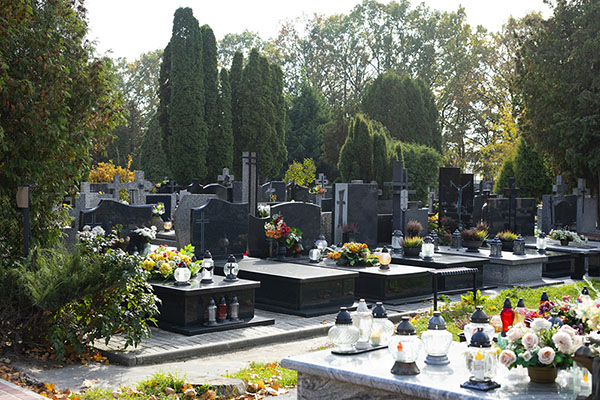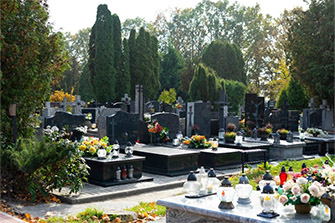 Gravestones are defined as a place marker of where someone is buried. More than just a memorial monument, gravestones are also a great way to remember, honor, and pay respect to those who have passed away.
Gravestones are defined as a place marker of where someone is buried. More than just a memorial monument, gravestones are also a great way to remember, honor, and pay respect to those who have passed away.
Gravestones usually have multiple engravings on them, such as the name of the person laid to rest, the date of their birth and death, and in some cases, a short message from the family. And if you walk around a gravesite, you’ll often see inscriptions and symbols on headstones too.
This tradition has been practiced for centuries. Some symbols such as those depicting faith and religions on grave designs are usually easy to decipher. There are also symbols of hearts, roses, flags, memberships to fraternities and organizations that you can easily tell the meanings.
Here’s a look at some of the popular symbols you’re likely to encounter when looking at gravestone designs and their meaning.
1 .Plants And Flowers
Flowers are among the popular symbols used in both traditional and modern gravestone designs. While the practice today is more for aesthetics and decoration purposes, the traditional practice for inscribing flowers on headstones and graves has a deeper meaning. Moreso, different plants and flowers carry different meanings.
The ivy is a symbol of friendship and an eternal embrace. You’ll mostly see it curved on different headstone shapes as though clinging on or growing around them. If you see lilies, they’re a symbol of innocence and purity for the one laid to rest. As for palm branches, they symbolize victory, peace, and immortality.
2. A Handshake Or Clasped Hands
Handshakes have various meanings in different cultures. In most cultures, it’s used as a symbol of peace because it shows that the person coming does not intend to bring any harm as they’re bare-handed. This symbol is also used to represent friendship, loyalty, and agreement.
When you encounter a symbol of clasped hands on headtsone designs, it symbolizes an eternal bond between the deceased and those left behind or the final farewell. In some instances, this symbol portrays a bond between two very close people, such as siblings, parents, or spouses.
3. Crosses
Crosses are among the popular religious symbols on gravestones that depict Christianity and faith. It also symbolizes resurrection and eternal life. But this symbol comes in many variations. Aside from the Christian cross, there’s also the Celtic cross
The Celtic Cross has equal arms fitted in a circle. It has been said that the history behind this symbol was merging the pagan and Christian symbols into one. The circle is the pagan symbol representing worshipping the sun, and the cross portrays the Christian faith.
However, a Celtic cross can have both religious and secular meanings. For instance, for some, a Celtic cross means the deceased is of British Isles or Irish origin.
4. An Anchor
This is another symbol commonly found in gravestone designs. Whenever you encounter an anchor, it might be that the deceased was a lover of the sea and water or was in the navy. On the other hand, it can also be used for spiritual symbolism to show strength and hope.
When the anchor on tombstone designs is combined with a broken chain, it may signify a life that was cut short, probably at sea.
5. Angelic Figures
Most of the time, when you see symbols either as images of angels or figurines on graves, that’s a symbol of innocence. This symbol is mainly used on children’s graves.
In the traditional sense, angels are seen as God’s agents. Moreover, it’s a representation of compassion and the afterlife where loved ones will encounter angels.
In some cases, when you see this on a tombstone design, it can also be a symbol of consolation giving a message to the bereaved that their loved one is in a better place.

6. Stars
A star on a grave is mostly a symbol of either of these two things; eternity or divine guidance. When it’s a hexagon—a star with six sides, it’s a symbol of creation. You’ll be most likely to find the hexagon in Eastern religions in areas that practice Hinduism.
The star also symbolizes dreams, hope, and eternal life. You can see stars curved on inscribed on simple grave designs and huge memorial monuments.
7. The Draped Urn
It wasn’t always common to practice burial in many cultures and traditions. Instead, cremating the bodies of loved ones and preserving their ashes was the common way of resting the deceased. After cremating the bodies, the bereaved would put these ashes in urns, similar to how it happens today.
However, as burials or laying loved ones to rest became more popular, people started making unique headstone designs that featured an urn to keep traditions alive. The drape on the urn is a symbol of protection to the soul as it transits to the afterlife.
Conclusion
Gravestones are a great way to keep honoring and remembering our loved ones. They carry various symbols and inscriptions that mean different things. That said, when choosing a gravestone design, take the time to research symbols and their meanings that can capture and embody the lives of the deceased.
Read more from our helpful blogs:

How To Choose A Burial Vault Without Overspending






Can you be more specific about the content of your article? After reading it, I still have some doubts. Hope you can help me.
I like this site so much, bookmarked
Very informative blogReally thank you! Awesome
Your point of view caught my eye and was very interesting. Thanks. I have a question for you.
How frequently do you check the vibration of your equipment? Vibration is a vital sign of the condition of machines and mechanisms, and ignoring it can cause major failures.
Devices like the Balanset-1A and Balanset-4 offer precise vibration measurements and timely detection of problems such as bearing wear or shaft misalignment. Regular vibration monitoring helps prevent unexpected failures and prolongs equipment life.
Users report significant reductions in breakdowns and downtimes after implementing regular vibration monitoring with the Balanset-1A. This not only saves money but also boosts overall productivity.
Don’t postpone taking care of your equipment. Start monitoring vibrations today with modern instruments and ensure reliable machine operation.
Here you can read more about On-site balancing services
industrial fan balancing
The Importance of Industrial Fan Balancing in Equipment Maintenance
In the realm of industrial equipment maintenance, the significance of industrial fan balancing cannot be overstated. Fans play a crucial role in numerous systems, and their performance is highly sensitive to any imbalance. Even the slightest deviation can lead to detrimental vibrations that threaten both the efficiency of operations and the longevity of equipment. For industries relying on various fan-operated machinery, neglecting this essential maintenance procedure can result in severe consequences, making fan balancing a paramount aspect of upkeep.
Understanding Fan Imbalance
Fan imbalance often arises from a correspondence between the geometric center of the fan’s shaft and its center of mass. If these two elements misalign—even minutely—the result can be devastating. The faster the fan rotates, the greater the necessity for precise balancing. Common causes of fan imbalance include:
Abrasive wear on fan blades
Dirt accumulation on the blades
Loose assembly or misalignment of the impeller and hub
Temperature fluctuations affecting housing and shaft
Loss of balancing weight
Deformation of blades
The repercussions of operating an imbalanced fan are significant. Increased vibrations can jeopardize the entire structure of the machinery, leading to higher energy consumption, premature failure of bearings, unplanned downtimes, and escalating repair costs. Conversely, a properly balanced fan enhances equipment efficiency, reduces stress on structural components, prolongs bearing lifespan, and significantly lowers operational noise. Thus, whether one is tending to a new installation or maintaining an established system, the importance of industrial fan balancing emerges as a non-negotiable step.
Beyond Fan Imbalance
While fan imbalance is often the leading cause of increased vibration, it is not the sole culprit. Other contributors include structural flaws, large mechanical clearances, issues with belt drives, and faults like misalignments or cracks. Therefore, it is imperative for seasoned vibration diagnostic specialists to conduct a thorough analysis of vibration sources before proceeding with fan balancing. Comprehensive equipment diagnostics ensures that all possible deficiencies are identified and rectified, paving the way for an effective balancing process only on technically sound machines.
The Process of Fan Balancing
Fan balancing, whether applied to an impeller or a fan wheel, is typically performed on-site using the fan’s inherent bearings. This methodology allows for maximum precision without disassembling the machinery, thereby avoiding unnecessary disruptions. The aim is always to achieve the lowest possible residual imbalance, adhering to the stringent standards set by ISO 1940-1-2007 relevant to the equipment class.
The procedure utilizes advanced devices, such as the portable balancer and vibration analyzer “Balanset-1A,” ensuring that every nuance of the balancing process is meticulously captured. The key steps in achieving fan balance comprise:
Strategic placement of sensors: Typically positioned on the bearings of the fan shaft and housing, sensors must be installed perpendicular to the rotor rotation axis.
Initial Measurements: Rotating the rotor to gauge the initial vibration levels.
Test Weight Adjustments: Installing a test weight on one plane, measuring vibrations again, and adjusting as necessary to ascertain the impact.
Final Adjustments: Continuing to add or adjust weights until the desired balance is confirmed, guaranteeing that every measurement and modification adheres to precision calibrations.
The Benefits of Professional Fan Balancing
Commissioning professional services for industrial fan balancing offers myriad advantages. Industry specialists possess the expertise to not only detect and correct imbalances but also uncover latent structural flaws that may contribute to greater challenges. Through detailed diagnostics followed by expert balancing, businesses can avert the catastrophic downsides of neglecting fan maintenance.
Moreover, utilizing sophisticated equipment like the Balanset-1A ensures that all measurements are accurate, leading to effective interventions that enhance the reliability and efficiency of the machinery. Ultimately, investing in fan balancing translates into savings down the line, as operational costs decrease and systems achieve enhanced performance.
Conclusion
In conclusion, the sphere of industrial equipment maintenance demands vigilant adherence to practices like industrial fan balancing. The consequences of neglecting this essential process can extend well beyond increased vibration; they can precipitate higher costs, unnecessary equipment repairs, and even production downtimes. Striving for optimum balancing is critical for achieving peak efficiency and maximizing the lifecycle of machinery.
Therefore, organizations must prioritize regular fan balancing as part of their maintenance strategies, ensuring that both new and existing systems operate with the precision and stability necessary in today’s competitive industrial landscape. In the end, the pursuit of balance is not merely a procedure; it is an investment in operational excellence, ushering in a future of reliability and effectiveness for industrial machinery.
Thank you for your sharing. I am worried that I lack creative ideas. It is your article that makes me full of hope. Thank you. But, I have a question, can you help me?
Thanks for sharing. I read many of your blog posts, cool, your blog is very good.
Your article helped me a lot, is there any more related content? Thanks!
Thanks for sharing. I read many of your blog posts, cool, your blog is very good.
Your point of view caught my eye and was very interesting. Thanks. I have a question for you.
Thanks for sharing. I read many of your blog posts, cool, your blog is very good.
information.|My family members every time say that I am killing my time here
Your point of view caught my eye and was very interesting. Thanks. I have a question for you.
nogensinde løbe ind i problemer med plagorisme eller krænkelse af ophavsretten? Mit websted har en masse unikt indhold, jeg har
You actually make it seem so easy with your presentation but I find this topic to be actually something that Ithink I would never understand. It seems too complicated and extremely broad for me.I am looking forward for your next post, I’ll try to get the hang of it!
Can you be more specific about the content of your article? After reading it, I still have some doubts. Hope you can help me.
Thank you for your sharing. I am worried that I lack creative ideas. It is your article that makes me full of hope. Thank you. But, I have a question, can you help me?
I don’t think the title of your article matches the content lol. Just kidding, mainly because I had some doubts after reading the article.
What a information of un-ambiguity and preserveness of precious knowledge regarding unpredicted feelings.
Your point of view caught my eye and was very interesting. Thanks. I have a question for you.
This article will assist the internet viewers for creating new webpage or even a blog from start to end.
I’m really impressed with your writing skills and also with the structure for your weblog.
Is that this a paid subject or did you customize it your self?
Anyway keep up the excellent quality writing, it is
rare to see a great blog like this one these days..
Having read this I believed it was very enlightening.
I appreciate you taking the time and energy to put this information together.
I once again find myself spending a significant amount of time both reading and commenting.
But so what, it was still worth it!
whoah this weblog is magnificent i really like reading your articles.
Keep up the great work! You understand, lots of persons are
searching around for this information, you can help them greatly.
Write more, thats all I have to say. Literally, it seems as though you relied on the video to make your point.
You clearly know what youre talking about, why throw away your intelligence on just posting videos to your site when you could be giving
us something informative to read?
Wow, incredible blog format! How lengthy have you
been running a blog for? you made running a blog look
easy. The whole glance of your web site is wonderful, let alone the content!
Saved as a favorite, I love your blog!
You really make it seem so easy with your presentation but I find this topic to
be really something that I think I would never understand.
It seems too complicated and very broad for
me. I am looking forward for your next post, I will
try to get the hang of it!
Good post. I learn something new and challenging on blogs I stumbleupon everyday.
It will always be helpful to read through content from other
authors and use a little something from their web
sites.
Why users still use to read news papers when in this technological
globe everything is existing on web?
excellent issues altogether, you simply won a new reader.
What would you suggest about your put up that you made some days in the past?
Any sure?
Awesome article.
I am genuinely glad to read this weblog posts which
includes lots of valuable information, thanks for providing
these kinds of statistics.
Hello friends, how is everything, and what you desire to say about this paragraph, in my view its
in fact amazing designed for me.
Hi, Neat post. There’s an issue together with your site in web explorer, would test this?
IE nonetheless is the market chief and a large
component of people will pass over your great writing because of this problem.
Hi there, just wanted to tell you, I loved this article.
It was helpful. Keep on posting!
Howdy! I could have sworn I’ve been to this blog before but after checking through some of the post I realized it’s new to me.
Anyways, I’m definitely glad I found it and I’ll be bookmarking and checking
back often!
This article gives clear idea in favor of the new visitors of blogging,
that genuinely how to do blogging and site-building.
It’s awesome to pay a quick visit this site and reading the views of all colleagues regarding this paragraph, while I am
also eager of getting experience.
This post will help the internet viewers for building up new webpage or even a blog
from start to end.
You ought to be a part of a contest for one of the best blogs on the net.
I most certainly will highly recommend this blog!
Hey! Do you use Twitter? I’d like to follow
you if that would be okay. I’m definitely enjoying your blog and look forward to new posts.
Howdy I am so thrilled I found your blog, I really found you by accident, while I was
researching on Yahoo for something else, Anyhow I am here now and would just
like to say thanks a lot for a incredible post and a all round entertaining blog (I also love
the theme/design), I don’t have time to read it
all at the minute but I have bookmarked it and also added your RSS
feeds, so when I have time I will be back to read much more, Please do keep up the awesome work.
If some one desires expert view on the topic of
running a blog after that i suggest him/her to pay a
visit this web site, Keep up the fastidious job.
Hi I am so happy I found your blog, I really found you by accident, while I was browsing on Digg for something else, Nonetheless
I am here now and would just like to say thank you for a incredible post and a all round
thrilling blog (I also love the theme/design), I don’t
have time to browse it all at the moment but I have book-marked it
and also added in your RSS feeds, so when I have time I will be back to read
more, Please do keep up the awesome work.
Hello to all, how is all, I think every one is getting more
from this web page, and your views are fastidious in favor of
new visitors.
Great post. I used to be checking constantly this weblog and I’m inspired!
Extremely helpful information specifically the ultimate phase :
) I take care of such information a lot. I used to be looking for this certain information for a very long time.
Thank you and best of luck.
I think the admin of this web page is actually working hard in favor of his website, as here every stuff is
quality based data.
My brother suggested I might like this web site. He was totally right.
This post truly made my day. You cann’t imagine simply how much time I had
spent for this information! Thanks!
Hello! This is my first visit to your blog!
We are a group of volunteers and starting a new initiative in a
community in the same niche. Your blog provided us useful information to work on. You
have done a outstanding job!
Greetings from Colorado! I’m bored to death at work so I decided to check out
your website on my iphone during lunch break. I really like the information you present here and can’t wait to take
a look when I get home. I’m amazed at how quick your blog loaded on my cell
phone .. I’m not even using WIFI, just 3G ..
Anyways, good blog!
I will immediately seize your rss as I can’t in finding your
email subscription hyperlink or e-newsletter service.
Do you’ve any? Please let me realize so that I could subscribe.
Thanks.
Attractive section of content. I just stumbled
upon your weblog and in accession capital to assert that I get in fact enjoyed account your blog posts.
Anyway I’ll be subscribing to your feeds and even I achievement
you access consistently fast.
Hello, i think that i saw you visited my weblog thus i came to “return the favor”.I’m
attempting to find things to improve my website!I suppose its
ok to use some of your ideas!!
Nice post. I was checking continuously this blog and I am impressed!
Extremely helpful info particularly the last part :
) I care for such info a lot. I was looking for
this particular information for a very long time. Thank you and best of luck.
I’ll immediately grasp your rss feed as I can’t to find your email subscription hyperlink
or newsletter service. Do you’ve any? Kindly allow me understand so that I may just subscribe.
Thanks.
Fantastic beat ! I wish to apprentice while you amend your site,
how could i subscribe for a blog web site? The account aided me a acceptable deal.
I had been tiny bit acquainted of this your broadcast offered bright
clear concept
Keep on working, great job!
First of all I would like to say superb blog! I had a
quick question that I’d like to ask if you don’t mind.
I was curious to find out how you center yourself and clear your thoughts before writing.
I have had a difficult time clearing my mind in getting
my thoughts out. I truly do enjoy writing but it just seems like the first 10 to 15 minutes are
generally wasted simply just trying to figure out how to begin. Any recommendations or hints?
Kudos!
Hi there! This is kind of off topic but I need some advice from an established
blog. Is it hard to set up your own blog? I’m not very techincal but
I can figure things out pretty fast. I’m thinking about making my own but I’m
not sure where to begin. Do you have any tips or suggestions?
Cheers
hello!,I really like your writing so a lot! share we keep in touch more about your article on AOL?
I need a specialist on this area to solve my problem.
May be that’s you! Having a look ahead to peer you.
Excellent blog here! Also your web site loads up very fast!
What web host are you using? Can I get your affiliate link to your host?
I wish my web site loaded up as fast as yours lol
Wow, amazing blog layout! How long have you been blogging for?
you make blogging look easy. The overall look of your web site is wonderful, as well as the content!
whoah this blog is fantastic i really like reading your articles.
Keep up the good work! You recognize, a lot of
persons are searching round for this information, you can help them greatly.
I every time emailed this blog post page to all my associates, since if like to read it then my friends will too.
Thanks for sharing your thoughts about Ricky Casino
live casino. Regards
I’m now not sure the place you’re getting
your info, however great topic. I must spend a while studying much more or figuring out
more. Thanks for fantastic info I was in search of this info for my mission.
Hey I know this is off topic but I was wondering if you knew
of any widgets I could add to my blog that automatically tweet my newest twitter updates.
I’ve been looking for a plug-in like this for quite some time
and was hoping maybe you would have some experience with something like this.
Please let me know if you run into anything. I truly enjoy reading your
blog and I look forward to your new updates.